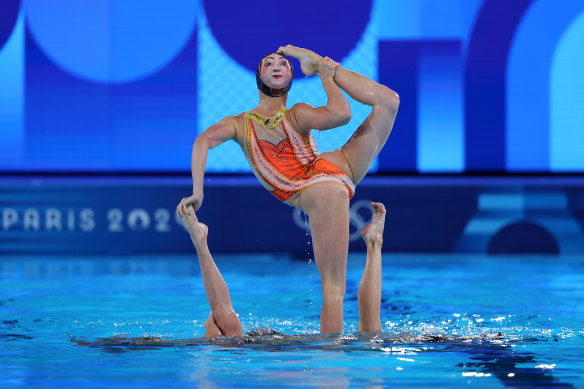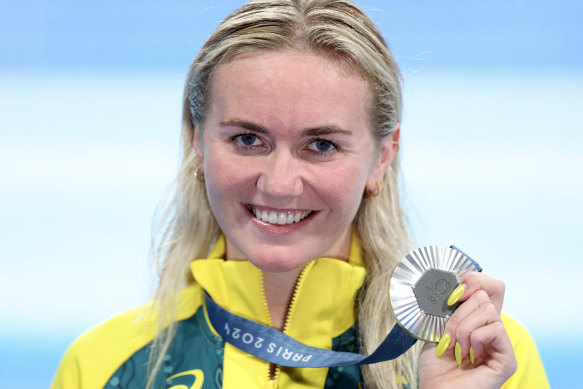Opinion
Online searches for ‘sex Olympics’ have hit the roof. I’m not surprised
Michelle Cazzulino
WriterGod bless those forward-thinking ancient Greeks. Long before today’s tricked-up, blinged-out, blow-dried, corn-rowed, ghetto-fabulous, Insta-famous athletes had applied a wax strip in anger, their Olympian predecessors had covered themselves in oil, stripped off their clothes and dispensed with fashion altogether. Not only was it considered acceptable to compete butt-bollock-naked, but the ancient Greeks encouraged it, believing that such displays of physical perfection were pleasing to the all-powerful Greek god Zeus, who has now assumed human form and goes by the name Anna Wintour.
So many muscles, so many sunglasses. If the 2024 Paris Olympics have proven anything it’s this: no matter how exceptional, in sporting terms, the current crop of athletes is, their commitment to Vogue-sanctioned aesthetics is such that their beauticians are working the same hours as their clinicians, statisticians and dietitians.

The synchronised swimmers’ largest piece of clothing is the peg on their nose. Almost. Credit: Getty Images
The experience of watching them at the peak of their competitive powers is akin to seeing a fleet of McLaren Sienna GTRs come purring around the corner. It’s expensive, explosive and exclusive. Only in this case, the McLarens in question have two dozen tattoos, a Brazilian, a nose piercing, a textured quiff and a shellac manicure featuring stars and stripes. And then there are their female counterparts.
As the cameras pan the field in the heats of the diving semis or the 100-metre dash, it quickly becomes apparent that no matter how good your ground game is, only one immutable law holds: the more attractive you are, the more screen time you command. God help you if you’re a slightly weird-looking goatherd from some far-flung corner of Scandinavia who came across your prodigious hurdling ability by leaping fences while chasing ornery livestock – you’re getting approximately two seconds’ airtime, while the camera comes to a fawning and semi-permanent stop on the emerging influencer-turned-sprinter from the Caribbean in the neighbouring lane.
We also need to discuss acrylic nails, which have inadvertently become such a theme of these Olympics that the IOC should probably consider treating them as a sport in their own right. Australian swimmer Ariarne Titmus was in trouble with spectators this week after she had the temerity to wear yellow nail polish while competing, but it was her nails’ length that really attracted online ire. One spectator accused her of gaining an unfair advantage because “they worked like paddles” and added a full 0.000000001 of a millimetre to her hand as it touched the wall.

Silver medal. Gold nails. Credit: Getty Images
Titmus’ nails, it should be noted, were significantly shorter than US sprinter Sha’Carri Richardson’s, which settled colourfully and tarantula-like on the starting line as she waited for the gun. They didn’t appear to feature heavily in any photo finishes, although fellow sprinter Noah Lyles’ “gender norm and critic-defying” manicures have also attracted their share of commentary in the media. US gymnast Simone Biles, meanwhile, got on the front foot, documenting her pre-Paris hair and nail appointments in a TikTok video, in which she also imparted one of the critical secrets to her gymnastics success: she does her own eyelash extensions.
If all of this seems like a frivolous sideshow that neither adds to nor detracts from the main event, it probably is. But in playing up their appearances and ramping up their social media content, the athletes are apparently responding to demand from the fans themselves. According to that well-respected online source of sporting reportage, Pornhub, searches for “Olympics” have spiked by 4876 per cent since the start of the Games. There has also been 505 per cent increase in searches for “athletes”, while other trending queries have included “sex Olympics”, “Olympic sex games” and “nude Olympics”.
In a bizarre postscript to the men’s pole vault earlier this week, France’s Anthony Ammirati, who lost his chance at an Olympic medal after his groin clipped the bar, was offered a porn deal worth a reported $250,000 after footage of the offending appendage went viral.
And that, dear reader, brings us back to the ancient Greeks and their cultural parallels with present-day athletes. At this point, we should also mention the forefather of modern athletics aesthetics, a runner named Orsippus of Megara, who was said to have lost his loincloth in the middle of a sprint. Instead of pausing to retrieve it, he apparently ran even faster, winning the stadion (the ancestor of today’s 200m) at the 15th Olympic Games in 720 BC. No word, however, on whether his naked frame featured acrylic nails, a freshly administered Brazilian wax, eyelash extensions or his children’s birthdates inked across his biceps in fetching Cyrillic script. Orsippus was euphoric, the gods were pleased and no doubt his Instagram account was immediately flooded with gold medal emojis posted by enthusiastic well-wishers.
Ultimately, that’s all that matters.
Michelle Cazzulino is a Sydney writer.